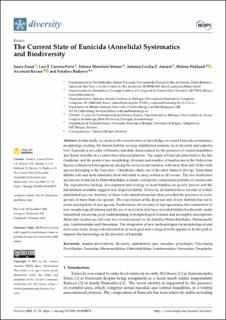| dc.description.abstract | In this study, we analyze the current state of knowledge on extant Eunicida systematics, morphology, feeding, life history, habitat, ecology, distribution patterns, local diversity and exploitation. Eunicida is an order of Errantia annelids characterized by the presence of ventral mandibles and dorsal maxillae in a ventral muscularized pharynx. The origin of Eunicida dates back to the late Cambrian, and the peaks of jaw morphology diversity and number of families are in the Ordovician. Species richness is heterogeneous among the seven recent families, with more than half of the valid species belonging to the Eunicidae + Onuphidae clade, one of the latest clades to diverge. Eunicidans inhabit soft and hard substrates from intertidal to deep waters in all oceans. The few freshwater species are restricted to Histriobdellidae, a family exclusively commensal/parasite of crustaceans. The reproductive biology, development and ecology of most families are poorly known and the information available suggests low dispersal ability. However, all families have records of widely distributed species. Scrutiny of these wide distributions has often revealed the presence of exotic species or more than one species. The exploration of the deep-sea and of new habitats has led to recent descriptions of new species. Furthermore, the revision of type specimens, the examination of new morphological features and the use of molecular data have revealed hidden biodiversity under unjustified synonyms, poor understanding of morphological features and incomplete descriptions. Molecular studies are still very few or nonexistent for the families Histriobdellidae, Hartmaniellidae, Lumbrineridae and Oenonidae. The integration of new methodologies for morphological and molecular study, along with information on biological and ecological traits appears to be the path to improve the knowledge on the diversity of Eunicida. | en_US |

